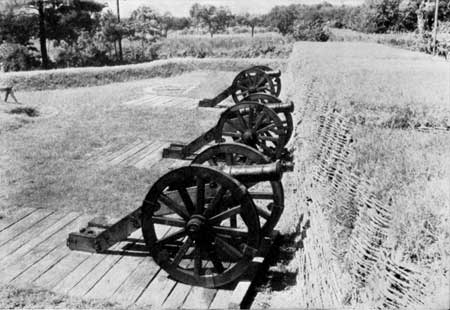MENU
|
Glimpses of Historical Areas East of the Mississippi River |
|
The Revolution |
|
VIRGINIA |

Restored Grand French Battery at Yorktown.
THE gradual concentration of opposing troops in Virginia made that State the main theater of military operations during the closing years of the Revolution. After a campaign of indecisive marches and counter-marches, the British under Cornwallis moved near the coast to obtain supplies and await developments. Here in the summer of 1781 they fortified Yorktown as a naval station for the British fleet in southern waters and as a military base for further operations in the interior. As the summer passed, Washington and Rochambeau, in command of the American and French armies, planned a decisive blow against the British. As a result of the prearranged arrival of the French fleet at a time when the allies were moving into position from the North, Cornwallis was surrounded by an overwhelming force. On the morning of September 28, 1781, Washington moved out of Williamsburg on the road to Yorktown. Under his command were 5,500 veterans of the Continental line, 3,000 Virginia militia, and Rochambeau's 7,600 seasoned French troops—a total of about 16,000 allies against half that number of British beleaguered in Yorktown.
The siege of Yorktown was primarily an artillery duel conducted according to orthodox eighteenth century tactics under the direction of Baron von Steuben, a veteran of the wars of Frederick the Great, who had come from Prussia to assist the Americans in their struggle for independence. From the bluffs overlooking the York River a French battery opened fire on the British ships, sinking H. M. S. Charon and several smaller vessels. The French cavalry on the Gloucester side of the river drove the British horsemen back upon their infantry. A detachment of Lafayette's Light Infantry commanded by Lt. Col. Alexander Hamilton carried with the bayonet an important British outwork. In retaliation the British made a brave but futile sortie. During these feats of arms the allies were skillfully pushing their trenches and batteries closer to the town and hammering away at Cornwallis' defenses.
A British battle fleet which had hoped to come to the assistance of Cornwallis had been beaten off by the French early in the siege. With no hope of relief, therefore, and his position desperate, Cornwallis asked for terms on October 17. The next day two representatives of each of the opposing armies met in the Moore House to draw up terms of surrender. In accordance with these terms, the British, on the afternoon of October 19, 1781, marched southward from the town on the old York-Hampton road. After the ceremony of the delivery of the sword, the British column was led to an open field where their guns were grounded and their mental standards delivered to the victors.
For the second time a strong British army had been forced to surrender to the Americans. In spite of many successful military exploits, England now was convinced that the American cause could be subdued not by campaigns in the field, but only by strong garrisons covering the whole of 13 colonies—a task beyond the resources of the British Empire. Peace now only a matter of negotiation.
 Top
Top
Last Modified: Thurs, Nov 23 2000 10:00:00 pm PDT
http://www.cr.nps.gov/history/online_books/glimpses3/glimpses2g.htm
![]()
